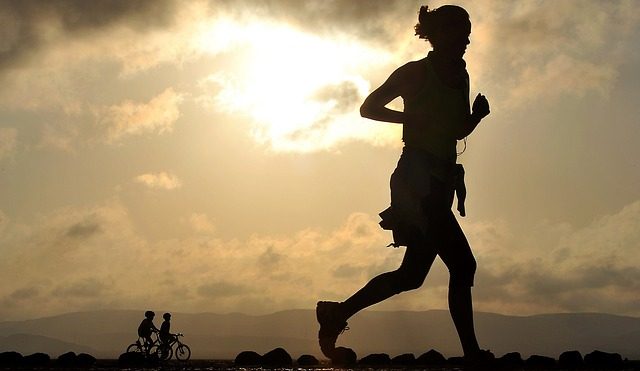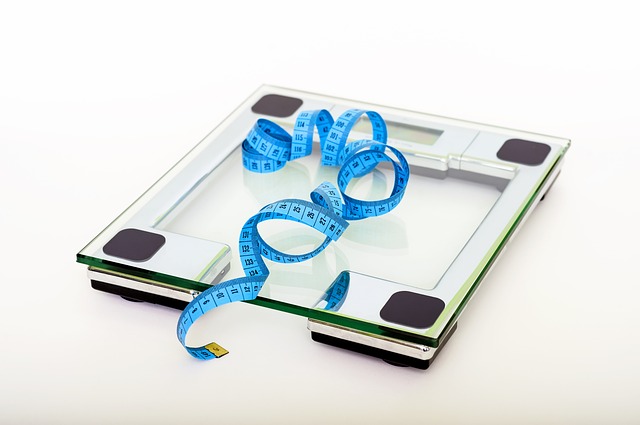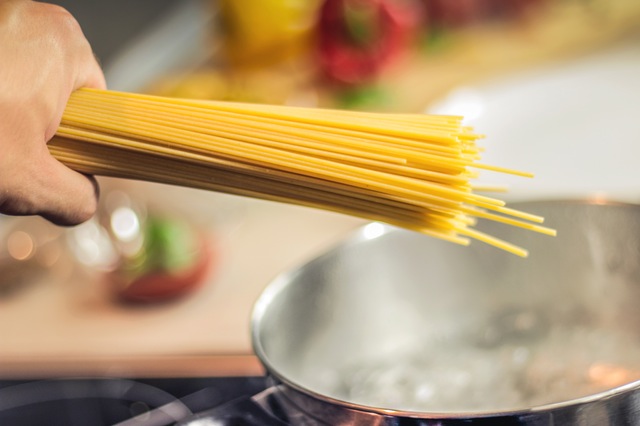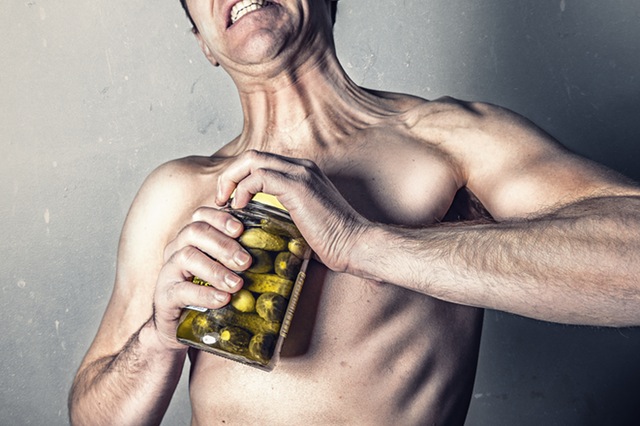
Every January, millions of Americans flood gyms around the country looking to shed the unwanted pounds of fat that come with eating too many cookies, drinking too much alcohol and dealing with the stress of the holidays. By the end of February, half of those same people (or more) stop going to the gym and fail to reach their new year’s resolution to look and feel better.
Although it’s sad, it’s not surprising. The truth is that losing fat is not easy.
Losing fat is NOT easy
The body is much more effective at storing fat than burning it. That’s because in nature there’s little reward for having a six pack. Instead, higher levels of body fat equal a greater chance of survival during a famine.
Although my focus has always been more on improving athletic performance than body composition, I’ve also trained countless people that just want to look good on the beach in the summer. (I put myself in that category, even though we only get a few months of sun here in Seattle.)
At one point or another, I’ve tried just about every type of diet known to man from ketogenic to intermittent fasting (IF) and everything in between. Today, I’m going to outline the strategy that I’ve come up with after years of trial and error.
In trying to find the best solution, I’ve always had three specific goals in mind:
- Burn the most amount of fat in the shortest amount of time without sacrificing strength, power or performance.
- Find a nutritional strategy that uses regular foods that the average person can actually follow.
- Prevent the inevitable dieting burnout that leads to rebound eating and a crash in hormones.
The solution I’ve settled on is a hybrid of several different strategies I’ve experimented with over the years. One part carbless post workout (CPWO), one part IF, a bit of old school bodybuilding, and a few other things thrown in for good measure.
I didn’t personally come up with any of the basic principles; Instead, I’ve simply tried them all and found the most effective way to fit them all together.
The basic strategy revolves around using two different types of days during the week:
fat loss days and training days. Each of them has a very specific goal and is set up differently, in terms of both training and nutrition.

Fat loss days: Get lean by training low and eating less
My approach to shedding unwanted fat starts with setting up specific days during the week that are designed to turn your body into a fat burning furnace. This requires a specific combination of both training and nutrition in order to get it right.
Instead of just taking the common path of slashing calories and doing as much high-intensity interval training as one can tolerate, I’ve come to utilize a fat loss formula, the most effective way to combine low-to-moderate intensity training with timed nutrition.
The result is that the entire day is set up to maximize fat loss, but at the same time, it won’t lead to the eventual downward spiral of hunger, decreased motivation and fat loss plateau that inevitably results from the more traditional approach.
The key to preventing this lies in the details, making sure both training and nutrition are coordinated. As you’ll see, when it comes to fat loss, less is often more.
The Fat Loss Formula
Bodybuilders have been doing fasted cardio since the 1980’s and by and large, for most people starting at a reasonable level of body fat in the first place, it has benefits. The primary among those, of course, is that it can increase the amount of fat being burned. This is simply because when the body is in a fasted state, the mobilization of fatty acids increases and this make it easier for your body to burn more fat.
This is nothing new or groundbreaking by any means, but there are a couple of important points to follow to make it even more effective.
First, you can increase fat burning even more by incorporating a few basic supplements into the pre-workout ritual. Aside from a typical thermogenic (personally I like Alphamine, but there are a million of them out there) I also include a few more that help facilitate energy production, insulin control, and fat loss.
My morning cardio pre-workout stack:
1 scoop Alphamine (or other thermogenic)
4 caps Mitochondrial NRG
1-2 caps Niacel-250
8mg Biotin
Next, a very important point to consider when doing fasted cardio is the type of cardio that you choose to do. Although in general there are benefits to using a variety of intensities within a program, in this case it’s best to stick to low to moderate intensities and avoid high intensity on the fat loss days.
The reason for this: inflammation.
Any time you’re in a glycogen depleted state (low carb), there is a greater level of inflammation that gets produced during higher intensity activities. If it’s only every once in a while it’s not a big deal, but when you’re training 4-6 days per week, additional inflammation can add up and start to have a negative impact on insulin sensitivity, among other things.

Cardio doesn’t have to kill you to burn fat
The most effective and appropriate types of cardio I like to use for these cardio sessions are cardiac output, tempo intervals and HICT. You can find descriptions of how to do these in various articles on this site, or in my book.
The goal here is to burn calories, primarily coming from fat, without incurring a ton of fatigue or stress to the point that you’ll end up over training if you train 5-6 days per week. One of the real keys to fat loss is consistency. Intensity will sabotage you if you use it indiscriminately.
How much cardio?
Thirty to sixty minutes in the morning of one of the types of cardio mentioned above is all you need. Depending on your body weight and how much fat you need to lose, you’ll want to shoot for somewhere in the neighborhood of 400-700 calories during the workout.
Although you’ll generally want to avoid much heavy lifting on these days—anything over 85% of max—you can throw in a moderate amount of accessory type work. This is where you can work on weak areas, but again you should keep the intensity on the low to moderate end. Even better, doing concentric only type exercises like sled drills or medicine ball exercises is a particularly good choice on the fat loss days.
Ideally, if you want to do this type of lifting, it’s best to do the cardio in the morning session and the accessory lifting in the evening, but if that’s not practical then they can be combined into a single session.
Also, if it’s simply impossible for you to do the cardio fasted in the mornings, then you can do it in the evenings instead. It’s not quite as ideal, but it’ll still get the job done.
Learn to write conditioning programs that get real results.
Spots open twice per year for a limited time.
Become a certified conditioning expert and watch your business and reputation grow.
If you’re an athlete that needs to incorporate skill training, you can either perform it in the morning and make that your cardio, or you can do a separate session in the evening.
The type of training you’ll want to do should be focused around improving technical aspects and learning new skills. This is where low to moderate intensities are most appropriate, so it makes the most sense to include this type of training on these days in particular.
The single most important rule to keep in mind on fat loss days is that more intensity and more calories burned is not always better. Too many people get themselves into trouble when it comes to fat loss by trying to do too much. When combined with the right nutritional strategy – which I’ll discuss below – the low to moderate intensity training approach will lead to fat loss without chronic inflammation, overtraining and the inevitable hormone crash that follows.

How to turn your body into a fat-burning furnace
What to eat on the fat loss days is relatively straightforward: low to moderate carbs, reduced calories and low fat.
This strategy creates the best environment for facilitating fat loss by keeping insulin low and cranking up the oxidation of fatty acids that’ll be burned during training.
Truth be told, all things being equal, many different carb/fat/protein combinations can work and the research shows that total calories are always the bigger driver of fat loss. That said, when it comes to meeting the objectives I discussed earlier—creating a sustainable diet that maximizes fat loss without sacrificing performance—using a cyclic approach of carb, fat and total caloric intake is the most effective.
Because you’ll only be creating a caloric deficit during the fat loss days, you’ll need to eat somewhere between 500-700 below maintenance levels. When you add in the calories burned from the cardio, you’ll be targeting a 900-1400 calorie deficit in total.
This would be too much if you were to try to do it every day, but in this case, you’ll only be only be in such a large deficit 4 days per week at most. This helps prevent the inevitable drop in thyroid and other hormones that happens when you keep calories too low, for too long.
As for macronutrients, you’ll want to set protein at roughly 1g per pound, keep fats to around 25% of total calories and then the rest will be carbs. For
For a 180-pound male with maintenance calories range of 2500, for example, he’d be looking at the following breakdown:
Targeted Calories: 2000
Protein: 720 calories = 180g
Fat: 500 calories = 55g
Carbs: 2000 – (500 + 720) = roughly 800 calories, or 200g
Keep in mind that I say “roughly” on all of these because calories and portion sizes are never an exact science, so these are just the general ranges to be targeted.
For the carbs, you’ll want to stick to the basic vegetable, low sugar, minimally processed type foods that are a part of pretty much every diet on the face of the earth these days. On a personal note, I love the new Green Giant frozen cauliflower rice and tater tots; they’re perfect on these days!
Protein and fat choices are fairly obvious: stick to a variety of protein sources from lean meats, chicken, fish, eggs, whey protein, etc. And don’t forget the usual healthy fats and oils. There’s literally mountains of articles out there on food choices so I won’t go into more detail, but you can always find plenty of good articles on the subject over at Precision Nutrition.
As for nutrient timing, the most important thing here is to maximize fat burning during the morning cardio and in the hour or two following it. This means that you’ll need to be fasted when you do the cardio and you’ll want to avoid eating for the next hour or two afterward.
After that, just keep the meals relatively balanced and stick to the calorie/macronutrient guidelines above. Personally, I prefer to have 2-3 bigger meals than 4-5 smaller ones, but I don’t think it ultimately makes much difference either way. All things and calories being equal, how many meals they are distributed across is mostly a preference thing more than anything else.
Aside from that, the only other thing to keep in mind is to have your last meal at least a couple of hours before bedtime and keep it a meal of protein and fat only. This will help maximize fat loss the following morning, whether you’re going to be doing another fat loss day, or even if you’re going to make it a lifting day, something I’ll talk more about in a minute.
Also, if you end up being unable to do your cardio in the morning fasted and have to do it in the evening instead, you’ll want to avoid carbs for 1-2 hours before the cardio session and again, just stick to the proteins and fats afterward.
As long as you follow the basic outline of eating and training laid out above, you’ll end up burning a significant amount of fat throughout the day. Although it may be tempting to think you should repeat this strategy every day, it doesn’t work.
Sooner or later your body will fight back and fat loss will grind to a frustrating halt (not to mention your strength will suffer and you’ll lose muscle mass.) The only way to prevent this is to balance the fat loss days with the lifting days, where you’ll use a whole different strategy.

Lifting Days: Train harder, eat more
As I just mentioned, the lifting days serve a very important purpose in that they help prevent the loss of muscle, strength and performance that’s all too common when dieting. They are also key in making sure your body doesn’t start down the downward spiral of inflammation, reduced insulin sensitivity and thyroid dysregulation that’ll inevitably happen if they aren’t included.
No matter how effective a diet might look on paper, if no one can follow it, what’s the point?
tweet thisEqually important, they make the fat loss days much easier to tolerate psychologically. Let’s face it, keeping your calories low and restricting your food choices is not particularly fun. Diets that are extremely monotonous and limiting day in and day out are generally not sustainable for the vast majority of people.
No matter how effective a diet might look on paper, if no one can follow it, what’s the point? To be honest, one of the main reasons I’ve ended up at the approach I’m outlining in this article is because it’s incredibly easy to follow.
The calories aren’t kept that low for very long and there’s a lot of variety so you don’t feel like it’s the same thing over and over again. Even though it’s designed to burn fat, it’s also easy to make a few tweaks and turn it into a long-term approach to healthy eating, regardless of any body comp goals.
What to eat and when to eat it
Because the overall goal of these days is to maintain (or even increase) strength and muscle, the underlying nutrition and training are different than on the fat loss days. First, instead of a caloric deficit, you want to eat as close to maintenance calories as possible. In other words, if you burn 3,000 calories in the day, you’ll want to eat right around 3,000 calories.
Second, the increased calories are going to come from carbs and fat. You’ll keep protein the same, roughly 1g / lb of body weight and you’ll increase fat slightly from 25 up to 30%. Just like before, the rest of the calories will come from carbs but since overall calories are increased, that means you get to eat more carbs!
Going back to our 180-pound guy example, a typical day during the lifting days would look like this:
Targeted Calories: 3000-3200 (2500 maintenance + 500-700 additional from training)
Protein: 720 calories = 180g
Fat: 1000 calories = 110g
Carbs: 3000 – (1000 + 720) = roughly 1580 calories or 400g
When it comes to food choices, you can now add some additional carb choices, ranging from simple to complex, depending your own food preferences and sensitivities. Grains, fruits, veggies, and whatever else you tolerate well are fair game, but timing is important here and a bit different than you might expect.
Although most people recommend eating a good percentage of daily carbs after training, I prefer a different approach—one taken from a strategy I came across several years ago called Carbless Post Workout (CPWO). Just as the name implies, you shift the carb intake to before the training session instead of after.

Why flipping conventional carb wisdom on its head has its advantages
First, you won’t feel “flat’ when you train and your strength, power and performance will all thank you for it. This is especially important if your primary training is not lifting, but skill training. The most important component to maintaining muscle mass, strength and performance is quality of training—and this is something that’s traditionally suffered during periods where fat loss was the goal.
With this approach, however, training sessions will remain much more productive. Personally, I’ve had my strength actually improve while I was losing fat and seen the same thing happen with clients as well. It’s worth noting that this is probably the only approach to dieting I’ve ever consistently seen this happen.
Another advantage to this approach is that it also minimizes inflammation because you’re not going into high-intensity training in a glycogen depleted state. This helps maintain insulin sensitivity and prevents negative feedback to the brain, part of which is mediated by inflammatory markers called cytokines, that can alter hormone function and leave you feeling tired and hungry.
The truth about post-workout carbohydrates
If you’re like most people, you’ve had the idea of the “anabolic window” drilled into your head and the idea that you have shove carbs into your mouth after a workout or else it’s impossible to get bigger or stronger. Without getting deep into the science, the truth is actually that protein after the workout is much more important than carbs when it comes to improving strength and muscle size.
Post-workout carbs become important when performance is on the line and you’re going to be competing, or doing some high-intensity training within the next 12-24 hours, but aside from that, keeping carbs low after the workout will actually improve fat burning. Because glycogen stores are depleted, the body will try to hang onto as much of it as possible and this means it will preferentially burn body fat instead.
This is the essence of the idea of carbless post workout strategy: maximize fat loss by keeping the body in a heightened state of fat burning after your high-intensity workouts by avoiding carbs.
Eating your carbs before your workout instead of after is a different approach than most people out there are preaching. I didn’t come up with the idea, but I will sing its praises.

How to get stronger while dieting
When it comes time to train on the lifting days, you can choose to just do a single high-intensity session in the evening, after you’ve had your carbs for the day. Or if you have more time, you can also include a light low-intensity session of fasted cardio in the morning.
Which one you choose to do really depends on whether or not your goal is just to burn fat, or also to improve your aerobic fitness along the way. If your aerobic fitness is slow and it’s practical for you, I suggest doing a 20-30 minute fasted session in the morning, basically the same approach as the fat loss days, waiting a couple of hours and then having your first meal of the day.
If you don’t need to improve your fitness, you can skip the morning session and just focus on the evening lifting session. Remember, you’ll want to get in your entire carb intake before the workout, so spread those out into 3-4 meals, or whatever you prefer, throughout the day and leading up to the workout.
The first thing you’ll notice is that because you’re not trying to lift heavy on low carbs, your strength will be much better than on typical diets. This is one of the things I like the most about this approach, you won’t feel flat and weak like you can on so many other diets. In fact, I’ve had several clients actually get noticeably stronger using this approach.
My suggestion is to use a mixture of heavier lifting, above 85% of max, along with some higher rep hypertrophy type work. You want to get enough heavy work in to stimulate the CNS, but you also want to deplete glycogen stores to help create a heightened fat loss environment the next day. Overall, a moderate volume is usually best.
If you’re an athlete that needs to do skill training, the high training days are, of course, where you’ll want to do your higher intensity skill work. A combat athlete, for example, should use these days for sparring and stick to lower to moderate intensity technical work on the fat loss days.
After the evening session, you’ll stick to high-protein, low-fat only and no carbs. Low-fat protein sources like lean meats and whey protein shakes are the easiest choices here. Depending on your body weight, you’ll want to shoot for 30-50g of protein within 1-2 hours after the workout.
A common strategy that works is to start with a protein shake first, immediately after the session, and then have one solid protein meal in an hour or two after that. Remember, the main thing here is to just keep both the carbs and the fat low to help set up the fat loss on the following day.
Putting it all together: How to set up your week
There are a lot of different ways to organize your overall weekly schedule, but you generally want to get in 4 fat loss days and 3 lifting days. It’s also most effective to follow up a lifting day with a fat loss day to take advantage of the heightened fat loss you’ll get from glycogen being a bit depleted.
This ratio of 4:3 of fat loss to lifting days will give you a large enough weekly caloric deficit to burn at least 1 lb of pure fat per week, without making you feel sluggish, depleted and weak. Even more important, it’s easily sustainable for most people and fat loss won’t plateau after a couple of weeks.
A typical weekly schedule could look like this:
Monday – Fat loss
Tuesday – Lifting
Wednesday – Fat loss
Thursday – Lifting
Friday – Fat loss
Saturday – Lifting
Sunday – Fat loss
You’ll notice that there are no days off. (There’s generally no need to take an entire day off of training because the fat loss days are relatively low intensity to begin with.)
Of course, you can take a day off of training if you’d like. Just make sure to reduce calorie intake on those days accordingly.
Once fat loss goals have been reached, you can return to whatever training and nutrition plan you want, or you use a variation of this same approach and modify calories and the weekly schedule accordingly.
To build lean muscle and/or improve strength, shifting to 4 lifting days and 3 fat loss days works extremely well in my experience.
All you need to do is add in the extra lifting day, reduce the caloric deficit on the fat loss days and make adjustments to your training based on what you’re trying to improve. Insulin sensitivity remains high, strength gains and performance are solid and you can build muscle without adding additional fat.
The simplicity, flexibility, and sustainability are the key reasons I’ve seen this approach work so well for so many people, myself included, over the last several years.

What to do next
Getting started with this approach is simple:
- Determine your basic maintenance calorie level. There are a million formulas out there to help if you have no idea where to start.
- Subtract roughly 500 calories from maintenance for your fat loss days. Set protein at 1g/lb of bodyweight, fat at 25% and the rest in carbs. Target burning 400-700 calories during the workout using low to moderate intensity methods only.
- On your lifting days, eat at maintenance calories. Either perform an additional cardio session in the morning or stick to an evening lifting session only. Spread your carb intake throughout the day out, but stick to no carbs and low fat after the evening workout.
- Organize your training week to have 4 fat loss days and 3 lifting days. Follow up each lifting day with a fat loss day, if you can. Once fat loss goals are met, reverse that and add calories in on fat loss days, or switch to another training and nutrition strategy.

The email you sent that linked to this article is doing you a disservice, Joel! I almost didn’t click it thinking that it was going to be a link to an ebook of some kind, but I clicked it and saw this article.
Wow! Excellent article with some great rational behind it.
Hi Joel,
Super helpful and thanks for the detail. The one section that I couldn’t understand is if we are adding to our maintenance calories the number being burned from workout , and then playing with the number after.
For example, my maintenance is 2500 cals. For lifting days, do I add to the calories from training (“Targeted Calories: 3000-3200 (2500 maintenance + 500-700 additional from training)”
OR
eat at 2500 on heavy lifting days.
Thanks!
For maintenance days, you want to eat the same number of calories you’d burn in the day, which includes the lifting portion.